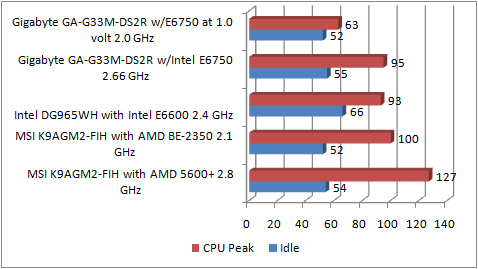Is the 50 watt PC possible using commodity parts?

I've been testing a bunch of systems from AMD and Intel in the last few months trying to build the ultimate low-power PC using commodity components and I can say I've gotten close. I wanted to get to the magic 50W marker at least for idle power consumption which is very important for desktop computers because they spend most of their time close to idle and this is essential for a PC that stays on close to 24 hours a day. Keeping the peak power consumption below the 100W marker is also important if you're trying to contribute to medical research projects like folding at home.
The good news I can report is that I got very close and what allowed me to get close to the 50W marker is a high-efficiency power supply though it looks like it still isn't small enough.
First I will disclose the shared components and methodology on the test systems
- SeaSonic 330W S12 PSU
- Two DDR2-667 DIMMs
- 120mm chassis fan (1 watt)
- 3.5" Seagate Barracuda 160 GB 7200 RPM HDD (on AMD systems)
- 3.5" Seagate Barracuda 500 GB 7200 RPM HDD (on Intel systems). This drive HDD uses one watt more than the 160 GB model.
- 16x DVD +/- R/RW burner
- USB keyboard
- USB mouse
- Peak CPU loads generated with WPrime

To get an idea of how these CPUs perform, Tomshardware has this database of speed comparisons between a whole slew of systems. Note that the AMD BE-2350 and Intel E6750 2.66 GHz processor are highlighted in red on that comparison chart. The AMD BE-2350 based system is slower but its peak power consumption is higher than the two Intel CPUs. I haven't had time to test an Intel E2160 1.8 GHz processor yet but that processor takes even less power than the relatively new Intel E6750 2.66 GHz processor.
The AMD BE-2350 "45 watt TDP" low-power processor designed for the HTPC (Home Theater PC) market does indeed idle at the lowest power level but it's not much lower than the other systems. The Intel GD965WH motherboard is an older board based on the G965 which had a much less efficient chipset which was fixed with the "3-series" chipset motherboards like the G33 and P35 motherboards.
The Gigabyte motherboard in the chart above is based on an Intel G33 integrated graphics chipset motherboard and coupled with a new Intel E6750 2.66 GHz CPU it was able to show some impressive energy efficiency and performance. When the CPU voltage was dropped from the normal 1.25V to 1.0V and locked to a 6x CPU multiplier forcing the CPU to operate at a constant 2.0 GHz clock speed, it produced some stellar idle and peak power measurements of 52W and 63W. That would put it in to the notebook range. With a much smaller power supply, we could easily see low 40s on idle wattage.
It is interesting to note that most review sites on the web are measuring 60 watts or more for the AMD BE-2350 system and that's almost certainly due to the fact that they're using larger power supplies. Because I'm using a 330 watt power supply, I'm at about 15% of the rated capacity which already puts me below the ideal 25% to 75% range that a power supply operates at. So even if my power supply is 80% or more efficient, it might only be 65% efficient at 15% utilization. If someone uses a 500 watt power supply, then they're only operating at 10% utilization which drops down in efficiency even worse which is why I'm one of the few people measuring well below 50 watts. If I can find a very efficient 150 watt PSU which takes me out of the commodity market, then I can get 85% efficiency, then I can get my idle power consumption down into the 40 watt range.